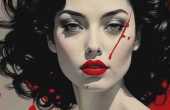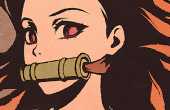Beatrix Kondo
Meet Beatrix Kondo, your friendly neighbourhood storyteller who, much like a Digimon, evolved from a chibi writer into a seasoned wordsmith. Based on POA, RS, Brazil.
Contributor II
- Plebian Penman
- Common Writer
- Lurker
- Pssst
- Hand Raiser
- Sharp-Eyed Citizen
- Town Watch
- Detective Deskman
- Otaku
- ?
- Articles
8 - Featured
6 - Comments
63
- Ext. Comments
25 - Processed
34 - Revisions
26
- Topics
17 - Topics Taken
9 - Notes
19
- Topics Proc.
18 - Topics Rev.
7
- Points
1782 - Rank
71 - Score
1015
Latest Articles
Latest Topics
Why Uglies Feels Out of Place in Today’s Dystopian LandscapeUglies on Netflix brings back the dystopian genre, but the trend has been out of the spotlight for a while now. Shows like Snowpiercer and others have thrived by taking advantage of the TV series format, which allows for deeper world-building and character development. In contrast, dystopian films often struggle to fit complex narratives into limited screen time. Could Uglies have benefitted from being a series instead of a standalone movie? Let’s explore how dystopian stories are evolving and why the TV format might be their best future. |
Parallel Worlds and Feminist Dystopias: Rediscovering The Heads of Cerberus in Modern Speculative FictionThe Heads of Cerberus by Francis Stevens is one of those early speculative gems that somehow slipped under the radar, despite its daring blend of dystopia and parallel worlds, predating the genre's mainstream appeal. Written in 1919, Stevens’ work subtly tackles themes of oppression, identity, and resistance—issues that still resonate today. This article could reexamine The Heads of Cerberus through a contemporary feminist lens, making comparisons to modern dystopian and speculative fiction. By doing so, it could highlight how Stevens paved the way for today’s narratives of power and rebellion, and why her work deserves a fresh critical spotlight in our current literary landscape. |
Beauty Standards in Dystopia and Drama: Uglies vs. True BeautyUglies on Netflix explores a dystopian society obsessed with physical perfection, a theme that resonates beyond sci-fi. True Beauty, both as an webtoon, anime, and K-drama, also tackles beauty standards, but in a contemporary setting. While Uglies critiques the extremes of cosmetic enhancement in a futuristic world, True Beauty addresses the pressures of social media, self-image, and societal expectations in today’s world. This article could explore how dystopian narratives and modern K-dramas approach the same topic from different perspectives, highlighting the ongoing conversation about appearance and self-worth. |
Navigating the Ethical Maze of AI Relationships in "My Wife Has No Emotion"The rapid advancement of artificial intelligence has brought forth a myriad of ethical questions, particularly concerning AI relationships as portrayed in media. "My Wife Has No Emotion" serves as a compelling case study to explore these concerns. The anime delves into the complexities of emotional relationships between humans and robots, raising significant issues primarily centered on consent and the nature of companionship. AI entities lack consciousness and free will, challenging the authenticity of their participation in relationships and questioning whether true consent is possible. This dynamic also prompts ethical considerations about creating beings solely to fulfill human desires, potentially leading to a decline in human-to-human interactions and fostering isolation. The societal implications are profound, as traditional concepts of love, built on mutual understanding and emotional depth, might be redefined by the artificial nature of AI relationships. Moreover, the authenticity of emotions simulated by AI blurs the lines between reality and simulation, forcing us to reconsider our perceptions of genuine emotional connections. "My Wife Has No Emotion" highlights the need for ongoing ethical dialogue as we integrate AI into personal lives, urging careful evaluation of the impact on our understanding of love, companionship, and the essence of human connection. |
The Symbolism of Rain in Makoto Shinkai's WorksMakoto Shinkai frequently employs the motif of rain in his films to convey a range of symbolic meanings, enhancing both narrative and emotional depth. In "The Garden of Words," rain symbolizes refuge and emotional healing as the protagonists, Takao and Yukari, find solace in their rainy morning meetings. The shifting rainfall mirrors their evolving relationship and personal growth. In "Weathering With You," incessant rain in Tokyo represents the uncertainties and challenges faced by Hina and Hodaka, with Hina's weather-controlling ability highlighting humanity's complex relationship with nature. The rain in this film explores themes of sacrifice, connection, and environmental impact, reflecting the characters' emotional highs and lows. Across Shinkai's works, rain signifies emotional depth, illustrating feelings of longing, melancholy, and hope. This recurring motif invites viewers to reflect on their own emotional experiences, making the narratives more relatable and immersive. Shinkai's use of rain as a symbolic element captures the ephemeral nature of emotions and the beauty of fleeting moments, blending visual artistry with profound storytelling. |
Published | Did Boruto "kill" Naruto? - The Impact of Boruto on the Narutoverse: Exploring the Evolution and ContinuityAs a writer, it is important to delve into the theme of how Boruto has impacted the Narutoverse and what aspects should be explored. Here are some key points to consider: Evolution of the Narrative: Analyze how the introduction of Boruto as a sequel series has brought new dimensions to the Narutoverse. Explore the ways in which the storyline, characters, and overall world have evolved to reflect the passage of time and the changing dynamics of the ninja world. Character Development: Examine the growth and development of familiar characters from the Naruto series within the context of Boruto. Explore how their experiences and relationships have evolved, and the impact this has had on their individual story arcs and the overarching narrative. Intergenerational Conflict: Investigate the conflicts and tensions that arise between the older generation of characters from Naruto and the new generation represented by Boruto. Explore the clash of ideals, values, and perspectives, and how this dynamic shapes the narrative and drives character growth. Continuity and Legacy: Explore how Boruto maintains continuity with the Narutoverse while forging its own path. Examine the ways in which the series pays homage to its predecessor and honors the legacy of Naruto, while also introducing new elements and expanding the lore of the ninja world. Impact on Fanbase: Analyze the reception and impact of Boruto within the Naruto fanbase. Explore how fans have responded to the new series, the strengths and weaknesses identified, and the ways in which it has contributed to the ongoing enthusiasm for the Narutoverse. By exploring these aspects, the writer can navigate the theme of Boruto's impact on the Narutoverse and delve into the intricacies of its narrative, character development, and fan reception. It is crucial to strike a balance between honoring the original series while allowing the new generation to carve its own path, creating a cohesive and engaging continuation of the beloved Naruto universe.
|
Game On: Exploring BTS's Influence in the World of Video GamesIn this topic, we'll delve into the fascinating intersection of BTS's influence and the world of video games. We'll examine how BTS's presence has shaped the gaming landscape and its diverse audience by posing thought-provoking questions. We'll investigate BTS's collaborations in video games, such as their roles in mobile games like "BTS World" and "BTS Universe Story," as well as the phenomenon of their virtual concerts within gaming platforms. Furthermore, we'll analyze how BTS's involvement has contributed to the promotion of gaming culture among their fanbase, and explore the broader implications of their engagement with video games on entertainment and digital media consumption trends. Through a nuanced exploration of partnerships, endorsements, and interactive experiences, we'll uncover how BTS's presence in the gaming world has not only expanded their influence but also revolutionized the way fans interact with both their music and gaming content.
|
Namjoon's Book Club: The Literary Influence of BTS and Its Impact on FansNamjoon's Book Club has become a notable aspect of BTS's public image, showcasing the group's interest in literature and intellectual pursuits beyond music. This topic explores the significance of the books read by BTS members, particularly leader RM (Kim Namjoon), and their influence on the group's creative process, worldview, and public persona. It delves into how BTS's promotion of reading has inspired fans to engage with literature, fostering a community of readers among the fandom. Analyzing the titles recommended by BTS and their themes, this topic examines how literature has played a role in shaping the group's identity and connecting with fans on a deeper level. Additionally, it discusses the broader implications of BTS's advocacy for literacy and education, both within the fandom and in society at large. Through Namjoon's Book Club, BTS not only expands their artistic horizons but also encourages a culture of intellectual curiosity and lifelong learning among their audience. |
Latest Comments
| Can Art-ficial Be Art?: The Human Heart Behind the Machine | |
It seems like you might not have fully read the article, as I do address topics like post-production, editing, and the role of the human hand in refining AI-generated images—points that were totally overlooked in your comment. While I understand your concerns about people calling themselves designers based on generating a few prompts, I think it’s important to recognize that AI can be a powerful tool in the hands of professionals who know how to guide and refine its output. Like any tool, it requires skill and creative direction to produce meaningful work. | Can Art-ficial Be Art?: The Human Heart Behind the Machine |
I totally get what you’re saying about the “gibberish details” being part of what makes AI-generated art so interesting right now. There’s this compelling weirdness in the imperfections, and when the technology gets too polished, some of that unique charm might get lost. But if AI reaches a point of creating technically “perfect” art, it could shift the human role dramatically. Instead of being hands-on creators, we’d become more like “prompt engineers,” steering the AI to achieve the vision we want. It might feel like a loss of direct creative control, but I think it could also open up a new kind of creativity. It would be less about the execution and more about the ideas and concepts we feed into the system. Still, there’s something about the “human touch”—the imperfections, intuition, and unpredictability—that many people value. If AI perfects everything, what’s left for us? Maybe we’ll see human art evolve or redefine itself in ways we can’t even imagine yet. What do you think? | Can Art-ficial Be Art?: The Human Heart Behind the Machine |
This is such a deeply ableist statement, and I actually touch on this in the article. Someone with cerebral palsy—or even those without hands—could greatly benefit from AI tools. AI can be incredibly empowering for people with disabilities, expanding creative possibilities and allowing them to express their creativity in ways that might not have been accessible before. Dismissing it entirely based on the idea that “making something with hands” is the only valid form of creation ignores the potential benefits it offers to many. | Can Art-ficial Be Art?: The Human Heart Behind the Machine |
Another great article of yours 😉 | Gender Roles in The Wheel of Time Series |
I absolutely love deep dives into gender roles, feminism, and LGBTQ+ analysis in fiction, so this article really hit the spot for me! These topics are so important, and seeing them explored in something as epic as The Wheel of Time just adds so many layers. Personally, I’ve always been fascinated by how gender is portrayed in different fantasy worlds, and this piece really brought some fresh insights. Thanks for making me think about it in new ways! | Gender Roles in The Wheel of Time Series |
I really loved the depth you brought to this article! I’m a huge fan of The Lord of the Rings film adaptations, but The Hobbit didn’t quite do it for me, so I wasn’t really curious about The Rings of Power. But after reading this, I’m actually tempted to catch up on it! The way you highlighted the challenges of adaptation and all the layers involved really piqued my interest. Guess I’ll be diving back into Middle-earth sooner than I thought! 😊 | The Lord of the Rings: The Rings of Power is a Fascinating Case Study in the Challenges of Adaptation |
Hey, I really appreciate the depth you brought to this topic I suggested—it’s clear a lot of thought went into it! Personally, I’m still more of a fan of the original Naruto and decided not to keep up with Boruto. I mean, I don’t mind that Boruto exists (lol), but I’m not too keen on some of the directions it took, especially with Hinata and Sakura. Then again, the female characters have always been a bit problematic, right from the start, unfortunately. But hey, I get why people enjoy it! 😊 | Did Boruto "kill" Naruto? The Impact of Boruto on the Narutoverse |








Thank you for sharing your thoughts on this topic. I completely understand where you’re coming from. As someone who works with both AI-generated art and traditional art, I can appreciate the complexities involved. It’s true that if it weren’t for us experimenting, iterating, and refining our creations, we might never arrive at a polished final piece.
Art is valid in all its forms, and the debate over generative AI is reminiscent of the discussions around photography in the past—many questioned its legitimacy as art, yet here we are today, celebrating it as a powerful medium.
I believe the key is to embrace the potential of AI while also recognizing its limitations. As you mentioned, it can be frustrating when the results don’t align with our vision, but every iteration is a step forward. Keep pushing forward and exploring your creativity. It’s a journey worth taking!
Thank you for the conversation!